-
Dendrobium nobile
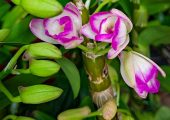
Dendrobium nobile is a general term for spring flowering varieties in the Dendrobium genus. Dendrobium nobile is a deciduous variety of Dendrobium officinale, which produces inflorescences on the upper stem nodes of the pseudobulbs in the previous year, with 2-3 flowers per bundle. After flowering, new buds grow from the base of the false bulb, which develops into new false bulbs in the same year. The old stem gradually shrinks and generally no longer blooms. Sometimes dormant teeth on the old stem will sprout and grow into small plants with roots, which are usually used as reproductive materials. After the autumn weather cools down, plants gradually enter a dormant period and form flower buds at low temperatures. Dendrobium nobile prefers…
-
Dendrobium bicameratum
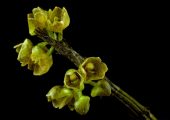
Dendrobium bicameratum Morphological features: Epiphytic plant, spindle shaped stem with grooves, 28.0-35.0 cm long and 0.3-0.6 cm thick, with 2-4 leaves near the top of the stem. The leaves are elongated and lanceolate, with a length of 4.0-8.0cm and a width of 1.8-2.5cm. The inflorescence emanates from the leafless stem nodes, nearly head shaped, 1.5-2.0cm long, with 4-6 flowers, pale yellow with dark stripes and spots. The length of the flower bud is 3.0-4.0mm; The middle sepal is wide and oval shaped, with a length of 6.0-6.5 mm and a width of 3.0-4.0 mm; The lateral sepals are wide triangular, 5.0-7.0mm long and 3.0-3.5mm wide, with a short calyx sac formed at the base; Petals long, round, ovate, 5.5-6.0 mm…
-
Dendrobium pulchellum
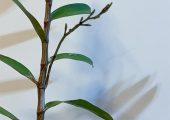
Dendrobium pulchellum It is named after the two dark spots on the petals, resembling the eyes of a dragonfly. It is a species of Dendrobium in the Orchidaceae family, with large flowers that are about 10 centimeters long and very beautiful. It is native to China, Laos and other places, and grows in the mountains at an altitude of about 70-2200 meters.
-
Dendrobium unicum
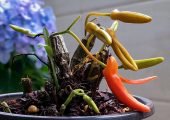
Dendrobium unicum,The meaning of the species name is “special and unique”, referring to its lips, which are reversed like rhinoceros horns and covered with deep orange red mesh patterns, very unique. This is a very attractive small species, which has become an important parent of mini Dendrobium nobile and atypical Dendrobium nobile. Although it does not have a full and round flower shape, the inheritance of orange red petals and muscular veins on the lips has made it stand out and gradually gained popularity. Distributed in Vietnam, Laos, Myanmar, and Thailand (at an altitude of 800-1550m), it grows on rocks and small shrubs in lowland forests. The flowering period is from spring to early summer, and the flower lifespan is…
-
Dendrobium farmeri
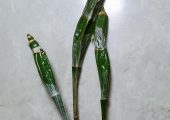
Dendrobium farmeri Also known as Den. farmeri Paxton, it belongs to the top leaf group Dendrobium officinale (Section of the top leaf (lantern) group) Dendrobium officinale and Dendrobium thyrsiflorum are closely related. Origin: Eastern Himalayas, Assam, Nepal, Myanmar, Thailand, Laos, Malaysia The stem of French Dendrobium is short and robust, usually in the shape of a four cornered rod, 8-30 centimeters long, with segments as thick as 2-4 centimeters. The lower part is often narrowed into a thick round four cornered shape, without branching, and sometimes the edges are very obvious, black light brown; The leaf is 3-5cm long, with a sharp tip at the tip and a sheath that does not extend downwards to embrace the stem. There are…
-
Dendrobium lituiflorum Lindl.
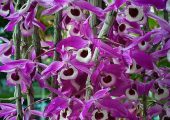
The stem of Dendrobium lituiflorum Lindl. is drooping, slightly fleshy, cylindrical, 30-40 centimeters long or longer, 7-10 millimeters thick, unbranched, with multiple nodes, and internodes 3-3.5 centimeters long. The leaves are papery, narrow and round, 7.5 to 18 centimeters long and 12 to 15 millimeters wide. The apex is gradually pointed and slightly hooked on one side, with a sheath at the base. Multiple racemes, originating from old stems with fallen leaves, each usually having 1-2 flowers; The inflorescence stalk is almost at right angles to the stem, 5-10 millimeters long, with 3 sheaths at the base; The sheath is light white, papery, up to 1.5 centimeters long, with a blunt tip; Flower bracts light white, ovate, 1-13 mm long,…
More...
Loading...